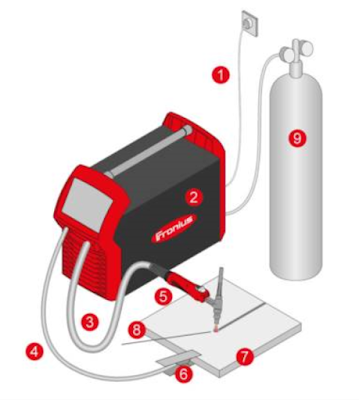Tungsten Inert Gas (TIG) Welding
TIG Welding is also a slang term
commonly used. Tungsten inert gas welding (TIG welding) is a gas shielded
welding process and is one of the fusion welding processes. TIG welding’s
proper name is Gas Tungsten Arc Welding or “GTAW". This is the name the
American Welding Society and other welding organizations refer to this process
on their welding procedures. TIG welding also goes by the term HeliArc welding.
When TIG welding was introduced around
the 1940’s Helium gas was the primary shielding gas used in process. The term
Heliarc welding was the common phrase used back in the day Most old timers and
veteran welders refer to TIG welding as Heliarc welding.
Since the name includes the term
“Tungsten" and tungsten is what makes TIG welding possible, it is good to
know what tungsten is! Tungsten is a very hard, slightly radioactive, and
brittle metal. At 3380 degrees Celsius, tungsten has the highest melting point
of all pure metals in the periodic system. This means that the electrode does
not melt when it emits an arc that heats and liquefies the material. In TIG
welding the tungsten is made into a non-consumable electrode that is used to
create the arc for TIG welding.
THIS IS HOW A TIG WELDING SYSTEM IS STRUCTURED:
(1) Mains connection
(2) Power source
(3) Hose pack
(4) Grounding cable
(5) Welding torch
(6) Ground terminal
(7) Workpiece
(8) Filler metal
(9) Shielding gas
TIG welding requires three things,
heat, shielding, and filler metal. The heat is produced by electricity passing
through the tungsten electrode by creating an arc to the metal. The shielding
comes from a compressed gas cylinder that flows to the weld area to protect it
from air. The filler metal is just a wire that is dipped by hand into the arc
and melted.
TIG Welding is a manual welding
process that requires the welder to use their both hands to weld. When TIG
Welding one hand is used for holding the TIG torch that produces the arc and
the other hand is to add the filler metal to the weld joint.
Shielding gas is selected according to
the material being welded. Argon - the most commonly-used shielding gas.
Helium and helium/argon mixtures
- adding helium to argon will raise the temperature of the arc. This promotes
higher welding speeds and deeper weld penetration.
In the TIG welding process the arc is
formed between a pointed tungsten electrode and the workpiece in an inert
atmosphere of argon or helium. TIG
welding must be operated with a drooping, constant current power source -
either DC or AC.
ADVANTAGES OF TIG WELDING
No formation of welding
spatter
Particularly high optical
quality of weld seams
All welding positions are
possible
Very high weld seam
quality
DISADVANTAGES OF TIG WELDING
Requires high degree of
skill
Low welding speeds
Rust must be removed
without fail when preparing the weld seam
Not suitable for thick
workpieces












